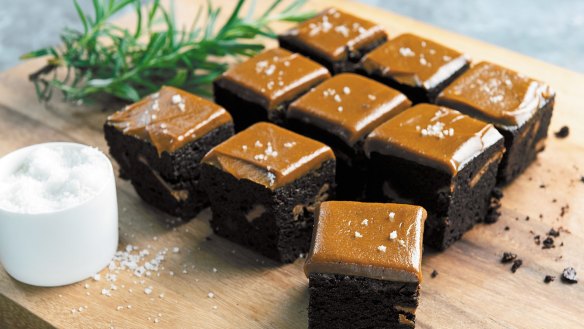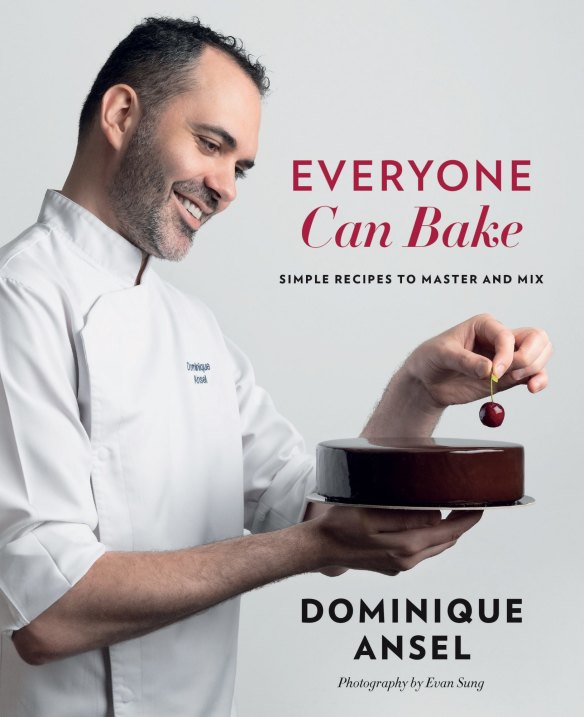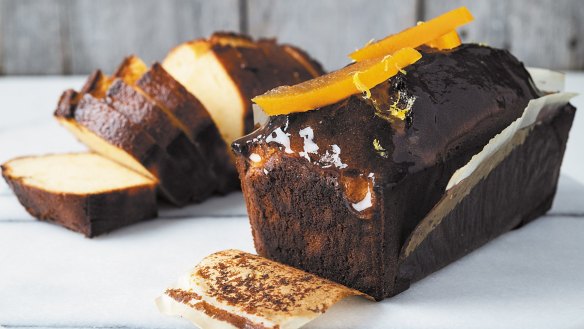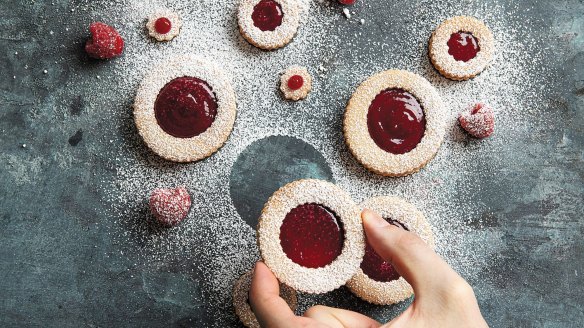Three recipes from cronut creator Dominique Ansel's new cookbook

Remember the cronut? The croissant-doughnut hybrid rose to early Insta-fame after being created by French-born pastry chef Dominique Ansel seven years ago.
With bakeries in New York, London and Los Angeles, Ansel went on to win World's Best Pastry Chef at the World's 50 Best Restaurants awards in Melbourne in 2017.
Now he is ready to share his techniques with home cooks in his new cookbook, Everyone Can Bake. Here are three simple recipes to master and mix.

My go-to chocolate brownies
I fell in love with brownies when I moved to America. My favourite pieces are the corner edges – I love how the top crunches at the first bite, yielding to a chewy middle. You don't often find this combination in French pastries. Like a chocolate chip cookie, people have preferences when it comes to brownies – they'll either seek the soft, gooey centre pieces or the chewy edges. This recipe gives you the best of both. These brownies are delicious on their own, but also make a terrific base for a mousse cake.
Makes: 16 (5cm) individual brownies or one 20cm round cake base (5 to 6.25cm tall)
Time: 45 minutes
INGREDIENTS
- 150g unsalted butter, at room temperature
- 300g white sugar
- 135g eggs (3 large)
- 70g cocoa powder, plus more for the tin
- 3g salt
- 4g baking powder
- 115g plain flour
- 225g chocolate chips*
- Go-to soft caramel to serve (optional; see recipe)
* I like using milk chocolate chips for this recipe, but you could use dark chocolate instead, or a combination of the two.
EQUIPMENT
20cm square cake tin or 20cm round cake ring
METHOD
- Preheat the oven: Preheat the oven to 175C fan-forced (195C conventional). butter the bottom, sides and edges of a 20cm square or round cake ring. Pour in some cocoa powder and shake it around until the tin or ring is evenly coated, then tap out any excess cocoa powder. Using cocoa powder instead of flour to dust your baking tin means there won't be any spots of white flour on the brownies when you remove them from the tin.
- Make the sugar mixture: Combine the butter and 100 grams of the sugar in a medium saucepan. Heat over medium heat, stirring slowly, until the sugar has dissolved and the butter has melted completely, 1 to 2 minutes.
- Make the egg mixture: Whisk together the eggs and remaining 200 grams sugar until smooth.
- Make the batter: Pour the sugar mixture into the egg mixture and whisk to combine. Add the cocoa powder, salt, baking powder and flour and whisk to combine. An easy way to sift dry ingredients is to combine them in a bowl and use a whisk to break up any lumps before adding them to a batter. Add the chocolate chips and fold them in with a spatula until evenly incorporated. Pour the batter into the prepared tin until it reaches halfway up the sides. If you are making a cake base, pour it into the cake ring set on a baking paper-lined baking sheet. If you are making individual brownies, pour it into a square baking tin. Level the surface with a spatula if needed.
- Bake the brownie: Bake for 30 to 35 minutes. Because of their dark colour, it's harder to tell when brownies are ready to come out of the oven. Look for the top of the brownies to set, with a few cracks in the surface.
- Unmould the brownie: If you baked the brownie in a cake ring, let it cool completely in the ring on the baking sheet, then unmould it by pulling up the cake ring. If you are making individual brownies, let them cool for 15 to 20 minutes until they are warm and set, then cut them into squares and serve. I like to remove the corner square first to make the other squares easier to get out.
- While brownies are baking and cooling, make a batch of my go-to soft caramel.
- To ice, pour soft caramel over the pan of brownies; let cool completely before slicing.
My go-to soft caramel
The best thing about this caramel is its texture – rich, smooth, a little chewy and very satisfying. It instantly adds an ooey-gooey factor that I love in desserts. Use it sparingly, though. You don't want to overwhelm, just add a drizzle of decadence.
Makes: 675 grams, enough to fill two 20cm tarts or one three-layered 20cm cake, with leftover caramel
Time: 45 minutes
INGREDIENTS
- 320g whipping cream
- 200g light corn syrup
- 50g dark brown sugar
- 100g white sugar
- 4g fleur de sel
EQUIPMENT
Digital thermometer
METHOD
- Make the cream mixture: Whisk together the cream, corn syrup and brown sugar in-a small saucepan. Bring to a boil over medium heat. Remove from the heat and cover to-keep warm.
- Make the dry caramel: Place another small saucepan over medium heat. When the pan is hot, sprinkle a thin, even layer of the white sugar over the bottom of the pan. As the sugar melts and caramelises, slowly whisk in the rest of the sugar, one handful at a time, making sure each handful of sugar has reached an amber brown colour before adding another handful. Once all the sugar has been added, cook until it has turned golden amber brown, 1 to 2 minutes. Remove from the heat immediately to keep it from-burning. (You can move the saucepan on and off the heat to control the temperature and make sure the sugar doesn't burn.)
- Combine the caramel and the cream mixture: While whisking, slowly pour one-third of the warm cream mixture into the caramel and whisk until incorporated. Be careful, as the caramel might bubble and spatter as you add the cream. Whisk in half the remaining cream mixture until incorporated, then whisk in the remainder. (A whisk works well here, but you can use a hand blender instead to give your caramel an even smoother consistency.)
- Clip a digital thermometer to the side of the pan. Reduce the heat to low and cook, whisking continuously, until the caramel reaches 105C, 4 to 5 minutes. Remove from the heat.
- Finish the caramel: Whisk in the fleur de sel. Pour the caramel into a large heatproof bowl and let cool completely. Once cool, stir well to re-emulsify any fat that has separated.
STORAGE
The caramel can be stored in an airtight container in the refrigerator for up to 3 days. Let the caramel sit at room temperature for 10 to 15 minutes and stir with a spatula to soften it before using.

Lemon pound cake
Pound cakes are sturdy: they travel well and keep well. If you need a cake to bring to someone's home, this would be my suggestion. I like to eat my pound cake plain – a thick slice goes well with a cup of tea.
Makes: One 20cm round cake or one 21x11cm loaf cake
Time: 1 hour 30 minutes
INGREDIENTS
- 225g eggs (4 large)
- 265g granulated sugar
- 135g creme fraiche, at room temperature
- 240g plain flour, plus more for dusting
- 4g baking powder
- 2g salt
- 90g unsalted butter
- 12g lemon zest (from 1 lemon)
- 100g fresh lemon juice
EQUIPMENT
20cm round cake tin or 21x11 cm loaf tin
Stand mixer with whisk attachment or hand mixer
METHOD
- Preheat the oven: Preheat the oven to 160C fan-forced (180C conventional). Butter the bottom, sides and edges of a 20cm cake tin or 21x11cm loaf tin. Pour in some flour and shake it around until the tin is evenly coated, then tap out any excess flour. If you're using a loaf tin, you can line the bottom and sides with baking paper instead of buttering and flouring it. (This makes clean-up a little easier.)
- Make the egg mixture: In a stand mixer fitted with the whisk attachment (or in a large bowl using a hand mixer), combine the eggs and sugar and whip on high speed until smooth and lightened in colour, 2 to 3 minutes. Put the creme fraiche in a medium bowl, add a large scoop of the egg mixture, and whisk it into the creme fraiche to lighten it. Add the creme fraiche to the bowl with the remaining egg mixture and gently whisk until fully incorporated.
- Combine the dry ingredients: Whisk together the flour, baking powder, lemon zest and salt in a separate medium bowl to break up any lumps.
- Make the batter: Fold the dry ingredients into the egg mixture in thirds, folding until combined after each addition.
- Combine the butter and fresh lemon juice in a small heatproof bowl. Microwave in 30-second increments, stirring after each to prevent burning, until the butter has melted. While whisking, slowly pour the melted butter into the batter and whisk until combined. (If you prefer not to use a microwave, melt the butter in a small pan over low heat. Remove it from the heat as soon as the butter has melted – you don't want the butter to brown.)
- If you're using a cake tin, pour the batter into the prepared tin until it reaches halfway up the sides; if you're using a loaf tin, fill it to about 1.5cm from the top.
- Bake the cake: Bake until the cake is golden brown, 55 minutes to 1 hour.
- Unmould the cake: Let the cake cool in the tin for 15 minutes. While the cake is still warm, turn it out of the tin, then turn it right side up and let cool completely.
My go-to nappage glaze
"Nappage" sounds fancy but is easy to make. Think of nappage as a protective neutral top coat for your desserts. To me, a tart isn't complete without nappage, especially since it helps prevent the cut surfaces of fresh fruits from browning over time. The nappage itself is only slightly sweet and doesn't carry very much flavour. But it's not to be missed if you're serious about presentation.
Makes: 500g, enough to glaze a 20cm cake, with leftover glaze
Time: 15 minutes
INGREDIENTS
- 150g white sugar
- 345g water
- 15g pectin NH*
* It's important to use pectin NH for this recipe. It's a type of pectin that's thermally reversible, meaning it can be set, melted and set again. Apple pectin will not work. Pectin NH is available in specialist baking suppliers.
EQUIPMENT
Pastry brush
METHOD
- Make the simple syrup: Combine about half the sugar and all the water in a medium saucepan and bring to a boil over medium heat. Remove from the heat.
- Make the pectin mixture: Whisk together the remaining sugar and the pectin in a small bowl until combined.
- Finish the nappage: Sprinkle the pectin mixture over the simple syrup and whisk until the sugar and pectin have dissolved. (Combining the pectin with some of the sugar before sprinkling it over the simple syrup prevents it from clumping.)
- Bring the mixture to a boil over medium heat. Cook for 2 minutes, then remove from the heat. Let cool for 10-15 minutes before using or storing.
STORAGE
The nappage can be stored in an airtight container in the refrigerator for up to 1 week. To use, microwave the nappage until it's hot and pourable, with a consistency similar to warm maple syrup (add a little water to loosen it up if it's too thick), about 30 seconds. If the nappage has separated, blend it using a hand blender for a few seconds to combine, then tap the container on the counter a few times to remove any air bubbles that may have formed during blending.

Linzer cookies
INGREDIENTS
- 185g plain flour, plus more for dusting
- 85g dark brown sugar
- 50g corn flour
- 4g ground cinnamon
- 4g ground ginger
- 1g salt
- 3g Tahitian vanilla bean (about 1/2), split lengthwise, seeds scraped
- 130g unsalted butter, cut into cubes, at room temperature
- 50g egg (1 large)
EQUIPMENT
20cm tart ring or tin
METHOD
- Make the dough: Combine the flour, icing sugar, corn flour, ground cinnamon, ground ginger, salt and vanilla seeds in a large bowl. Add the butter and mix with your hands until the butter is broken down into pieces the size of peas and the ingredients are well combined. (Alternatively, use a stand mixer or hand mixer to combine the ingredients.) Add the egg and mix with a spatula until the dough is smooth and the egg is fully incorporated. Don't overmix.
- Chill the dough: Turn the dough out onto a large piece of plastic wrap and gently shape it into a ball. Wrap the dough in the plastic wrap and flatten it into a disc. Refrigerate for at least 30 minutes or up to overnight, until cold but still pliable. It should have the texture of clay. Flattening the dough into a disc will help it chill faster. You'll want to make sure the dough is cold before rolling it out. Working with dough that's too warm will cause the tart shell to shrink as it bakes.
- Preheat the oven: Place a rack in the centre of the oven and preheat the oven to 175C fan-forced (195C conventional).
- Roll out the dough: Flour your work surface and rolling pin. Unwrap the dough and place it on your work surface. Roll it out into a rectangle about 6mm thick. If you find that your dough is sticking to the rolling pin or work surface, add some more flour. Then roll it out between two sheets of baking paper. Baking paper also makes it easier to lift the rolled-out dough onto the baking sheet later on.
- Shape the dough: Use your favourite cookie cutter to cut shapes from the dough. With a smaller cookie cutter, cut a smaller shape from the centre of half the cookies.
- Arrange all the cookies on a baking paper–lined baking sheet and bake in a preheated 175C fan-forced (195C conventional) oven for 10 minutes. Let cool completely in the pan.
- Turn the cookies without the centre hole bottom-side up and dollop a teaspoon of your favourite jam (or see recipe below) onto each. Dust the cookies with the centre hole with icing sugar and place on top of the jam. Push down slightly to make a sandwich.
- Once assembled, the cookies can be stored in an airtight container in a cool, dry place for up to 2 days.
Berry jam
Think of jam as a way to make fruit taste instantly riper: this process intensifies flavour and preserves it. That's why they are such great additions to cakes and tarts, both in and out of season. I often fill raspberry tarts with raspberry jam to amplify them, so pockets of jam burst out when you take a bite. And of course, extra jam never goes to waste – spread it over toast or swirl it into vanilla ice-cream.
Makes: 600g
Time: About 1 hour
INGREDIENTS
- 200g white sugar
- 24g powdered apple pectin
- 700g fresh berries*
* If you prefer your jam to be seedless – if you're making a blackberry jam, for example – strain it through a fine-mesh sieve before letting it cool.
METHOD
- Make the pectin mixture: Combine the sugar and pectin in a medium bowl and stir until well mixed.
- Make the peach mixture: Place the berries in a large bowl. Sprinkle the pectin mixture evenly over the berries and stir until incorporated. Make sure to sprinkle the pectin mixture evenly, or it will clump.
- Cook the jam: Transfer the peach mixture to a medium saucepan, cover and bring to a simmer over medium heat. Cook, stirring occasionally and adjusting the heat as needed if the mixture threatens to boil over, until the peaches have broken down and the mixture is thick and jammy, 30-45 minutes. Remove from the heat.
- Use or store the jam: If you'll be using the jam immediately or within a few days, let it cool completely.
STORAGE
The jam is best enjoyed the same day it's made, but once cooled, it can be stored in an airtight container in the refrigerator for up to 4 days.
This is an edited extract from Everyone Can Bake by Dominique Ansel, photography by Evan Sung. Murdoch Books RRP $49.99. Buy now
Appears in these collections
From our partners
Original URL: https://www.theage.com.au/goodfood/three-recipes-from-cronut-creator-dominique-ansels-new-cookbook-20200604-h1ojay.html